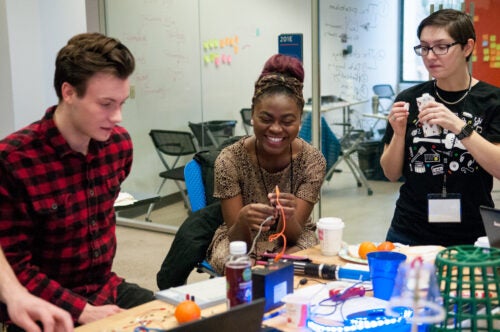
Idaho has a rich heritage of innovation in the building fields dating back to the indigenous people who used native materials to build their homes, to the 1860s when pioneers adopted mud brick construction after realizing that the cottonwoods growing along the Boise River didn’t suit their building purposes.
Innovation continued with Boise’s use of geothermal springs to heat homes and scores of buildings, including some on the Boise State campus, and continued into the post-World War II era and beyond with companies like Trus Joist. The company built lightweight structural beams visible in buildings like the Boise Little Theater, the Kibbie Dome at the University of Idaho and in homes across the state.
Boise State’s inaugural Hacking for Homebuilding competition, Oct. 15-22, embraces this Idaho tradition of ingenuity. The event, hosted by the College of Innovation and Design’s Venture College and the College of Engineering, will challenge student teams to solve 25 real problems posed by experts in the home building industry. The event is open to students at higher education institutions in Idaho. Teams can include members from different institutions. The Venture College is encouraging teams to work remotely.
Nic Miller, Venture College executive director, said the problems will range from big picture issues like finding ways to support affordable housing to more “granular” challenges like what to do with swaths of plastic that wrap lumber for transport or how to clean up waste, including nails and other potentially damaging materials from construction sites – or even finding high tech ways to keep those sites safe from theft as lumber prices rise.
Could Boise become the home of construction-tech startups?
Student teams will choose a problem, then spend a week working with mentors from the community and the Venture College. At the end of the week (Oct. 22), teams will pitch their ideas to industry experts, entrepreneurs and investors. Those judges will choose the top three teams to pitch their ideas during Boise Startup Week beginning Oct. 26. In addition to the opportunity to network and find a potential market for their ideas, winning teams will receive cash prizes: $10,000 for first place, $5,000 for second place, $2,500 for third place.
“The most exciting thing about this event is that it’s flipped the entrepreneurial model,” said Miller. “Traditionally, entrepreneurs pitch ideas independent of problems. Here, entrepreneurs start with a problem – and a potential customer base.”
Levi Smith, president of Franklin Building Supply, one of Hacking for Homebuilding’s industry partners, said he wants to engage established businesses like his 40-year-old company with Boise’s growing start-up scene, as well as help students “take a leap forward in their entrepreneurial journeys.”
“If you survey the U.S. today, there are no startup ecosystems which have really laid claim to being the place for startups in agricultural-tech or construction-tech,” said Smith. “I believe the timing is right for Boise to be the place people think about for those startups, but it will require all the pieces of that ecosystem coming together to make those domains a focus.”
Those pieces include steady support from Idaho’s educational communities, said Smith. Working with the Boise State Venture College on the first Hacking for Homebuilding was “an obvious path forward given the resources, track record and enthusiasm of its leadership.”
Looking for diverse perspectives
Miller said he’s met with departments across campus to spread the word about the competition, including construction management and other departments one might associate with a building challenge. But he’s also met with the School of Public Service, the College of Arts and Sciences, and others. He hopes that not only will teams include members from different institutions, they will include students across disciplines.
“We want a diversity of perspectives, people with different tools in their tool belts, who will approach problems in different ways,” said Miller. “It’s an opportunity for all disciplines to engage. Because everyone needs a shelter.”
JoAnn Lighty, dean of the College of Engineering, said she’s eager to see more hacking events come to campus.
“It is a great opportunity for our students, and students across campus, to work together and solve industry issues in interdisciplinary teams which reflect a work environment. In addition, this event will let our students learn more about and connect them with industry,” said Lighty.
In addition to Franklin Building Supply, Hacking for Homebuilding partners include Idaho State University, University of Idaho, Boise Cascade, Eaglewood Homes, Franklin Building Supply, Midwest, Trus Joist, and Weyerhaeuser.
- A Hacking for Homebuilding information session is scheduled for Oct. 7. Sign up and find more information.
End note: The mud brick/Boise State connection
The house of Boise Mayor Thomas Logan, built between 1863-1868 of sun-dried mud brick or adobe, stood for nearly a century near N. 6th Street and Grove Street in downtown Boise. In 1970, when the house was threatened with demolition to make way for a parking lot, local preservationists rallied. It was none other than Eugene Chaffee (Boise State president from 1936-1967, then chancellor until 1970) who led the fundraising effort to save the building by moving it to a new site. One of the few remaining examples of adobe construction in the city, the Logan house now sits protected on the grounds of the Idaho State Museum. It earned its listing in the National Register of Historic Places in 1971.
– Story by Anna Webb